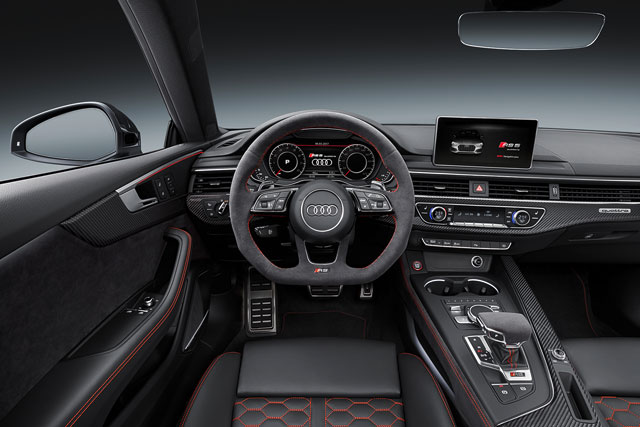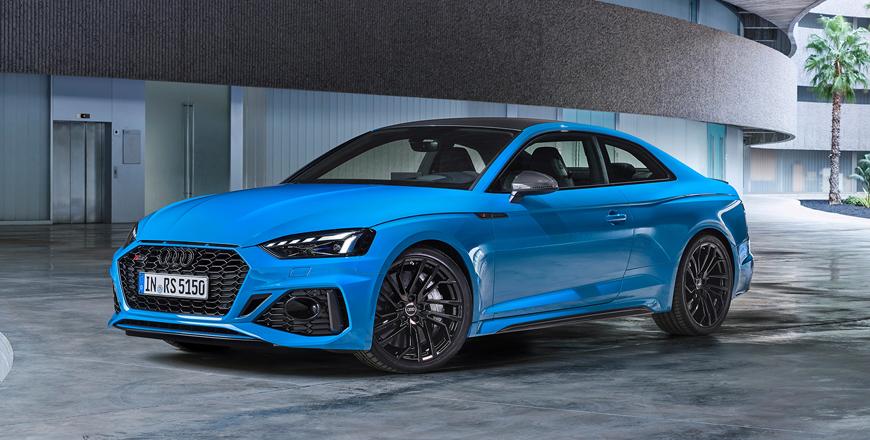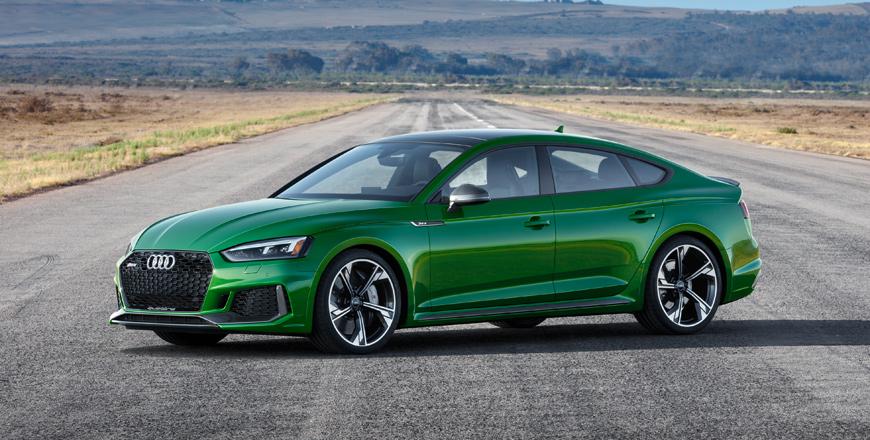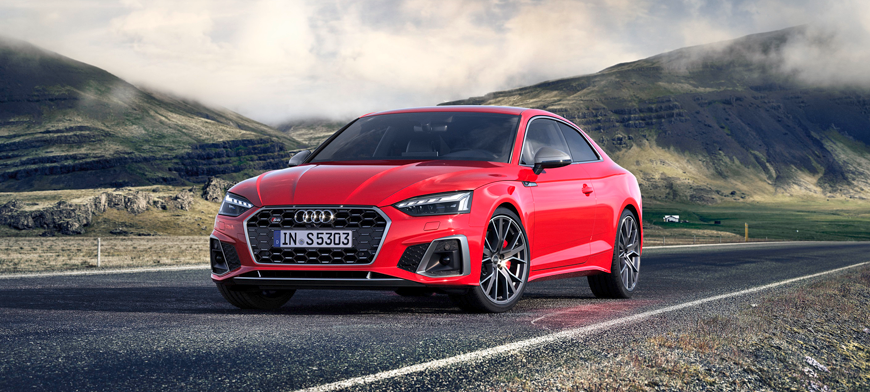You are here
Audi RS5 Coupe: Quattro comeback, in name only
By Ghaith Madadha - Apr 23,2018 - Last updated at Apr 23,2018

Photos courtesy of Audi
By virtue of occupying the same position in Audi’s range as a high performance coupe variant based on the same basic platform as the brand’s junior executive saloon, the new Audi RS5 Coupe is for all intents and purposes, the latest and most potent successor to Ingolstadt’s most defining and iconic 1980-91 Quattro. Though not being actively promoted as such, and without its predecessor’s rallying links, the RS5 may be thoroughly more modern and sophisticated, but retains its famous predecessor’s basic formula and shares a similar rivalry with the BMW M3.
Knowing nod
The most nimble of the traditional longitudinal front engine current Audis, the RS5 still does things a little different to its premium coupe M3 and Mercedes-AMG C63 Coupe rivals, with more emphasis on dogmatic road-holding and tenacious traction, courtesy of its Quattro four-wheel-drive. And like its German rivals, the RS5 has downsized its engine capacity — to an all-new 2.9-litre V6 — and adopted twin-turbochargers without forsaking power or performance. With its smaller and lighter engine partly accounting for its enhanced agility, the new RS5’s performance improves on its immediate naturally-aspirated 4.2-litre V8 RS5 predecessor’s.
Sharing the garden-variety A5 base model line’s sleek and sophisticated design, the RS5 features similarly swept back and moodily browed headlights, snouty and vast grille and elegantly long, flowing lines. With an almost fastback look roofline and rear quarters and thick C-pillars, it harks back to the Quattro, but it is the beefier RS5-specific bulging and blistered wheel-arches, which most pointedly reference the iconic Quattro. Additional RS5-specific design elements include honey-comb grille design, bigger intakes, sharper and lower front lip, more defined side skirts and more pronounced rear air diffuser and huge dual oval exhaust tips.
Responsive and rapid
Under a long ridged bonnet, the RS5’s potent twin-turbo direct injection V6 engine is mounted low and in-line, just ahead of the front axle. Driving all wheels through a smooth and slick 8-speed gearbox with escalatingly aggressive auto and paddle-shift manual modes, the RS5’s engine develops 444BHP at 5,700-6,700rpm and a thick forceful wave of 4,42lb/ft torque throughout a broad, accessible and versatile 1,900-5,000rpm mid-range. Quick-spooling and virtually-lag free, the RS5’s engine is responsive from idling, while its Quattro system ensures vice-like traction at launch, which help return a supercar-like 0-100km/h sprint in just 3.9-seconds.
As powerful as its predecessor, but with significantly quicker and with more torque, the new RS5 may not reach the same lofty rev limit in excess of 8,250rpm, but is eager, crisp and high revving for a turbocharged engine. Capably of 280km/h with optional speed derestriction, the RS5 is, however, also more fuel efficient than its predecessor, and with stop/start system, can return 8.7l/100km combined cycle consumption. Different in character than the outgoing RS5, the new model also takes on a dual personality in its own right, depending on how one configures its various adjustable driving modes.
From smooth to snarling
Smooth, refined and quiet to the point of seeming docility in terms of acoustics when in Comfort mode, the RS5, however, adopts a sharper throttle profile and a more muscular, viciously vocal, snarling and wailing engine and exhaust tone when Dynamic mode engine and exhaust modes are activated. A hugely capable high performance sports coupe with seamlessly swift gearbox, the RS5’s progress is effortlessly rapid, with blistering acceleration from standstill and a deep mid-range providing immediate mid-range response. Meanwhile, the RS5’s high strung torque plateau arrives with and explosively urgent progression.
Accessible, effortless and reassuring for daily driving, the RS5 is manoeuvrable in town with light Comfort mode steering, refined inside, settled and stable at speed and committed through corners and in low traction conditions. A more user-friendly, comfortable and luxurious car than its Quattro predecessor, and not unlike its S5 junior performance coupe sister model, the RS5’s character and controls, however, sharpen up and become more responsive and focused in Dynamic mode. To better experience its sporting potential, one does need to push closer to the edges of huge dynamic and performance envelope.
Agile ability
The smallest, lightest and most nimble of Audi’s traditional front inline engine models, the new RS5’s lighter engine and more sophisticate five-link all-round suspension help make it unexpectedly eager, crisp, tidy and agile on turn-in for its front-biased weighting. Riding on fixed rate sports suspension, the RS5 is smooth and firm without being uncomfortable over imperfections, yet is flat and well-controlled through corners. Meanwhile, its rear-biased four-wheel-drive — and optional rear sports differential — are able re-apportion power front and rear and along the rear axle to the wheel that can best put it down to tarmac.
With comfortable, supportive quilted leather seats, well-adjustable driving position, good visibility and chunky sports steering wheel, one feels involved and alert when driving the RS5 through corners and switchbacks. Able to carry high speed through tight corners with ease, the RS5 is more than a one trick pony, and with a dab of mid-corner braking or throttle lift-off, is eager to pivot and tighten a cornering line before blasting out of a corner as throttle is reapplied. Steering is meanwhile accurate, brakes reassuringly capable, while interior design, quality and ergonomics of a high level and infotainment, convenience and driver assistance systems extensive.
TECHNICAL SPECIFICATIONS
- Engine: 2.9-litre, twin-turbocharged, in-line V6-cylinders
- Bore x stroke: 84.5 x 86mm
- Compression ratio: 10:1
- Valve-train: 24-valve, DOHC, direct injection
- Gearbox: 8-speed automatic, four-wheel-drive
- Ratios: 1st 5.0; 2nd 3.2; 3rd 2.143; 4th 1.72; 5th 1.313; 6th 1.0; 7th 0.823; 8th 0.64
- Reverse/final drive: 3.478/3.204
- Drive-line: Self-locking centre differential, optional rear sport differential
- Power, BHP (PS) [kW]: 444 (450) [331] @5700-6700rpm
- Specific power: 153.3BHP/litre
- Power-to-weight: 268.1BHP/tonne
- Torque, lb/ft (Nm): 442.5 (600) @1900-5000rpm
- Specific torque: 207.3Nm/litre
- Torque-to-weight: 262.5Nm/tonne
- 0-100km/h: 3.9-seconds
- Top speed (optional de-restriction): 250km/h (280km/h)
- Fuel consumption, urban/extra-urban/combined: 11.5-/7.1-/8.7-litres/100km
- CO2 emissions, combined: 197g/km
- Fuel capacity: 58-litres
- Length: 4,723mm
- Width: 1,861mm
- Height: 1,360mm
- Wheelbase: 2,766mm
- Track, F/R: 1598/1,588mm
- Overhangs, F/R: 918/1,039mm
- Aerodynamic drag co-efficient: 0.316
- Headroom, F/R: 1,005/920mm
- Shoulder width, F/R: 1,404/1,287mm
- Luggage volume: 465-litres
- Unladen/kerb weight: 1,655/1,730kg
- Steering: Electric-assisted rack & pinion
- Turning Circle: 11.7-metres
- Suspension: Five-link, anti-roll bars
- Brakes: Ventilated, perforated discs
- Tyres: 275/30ZR20
Related Articles
The modern day successor to the game-changing 1980-91 Audi Quattro that popularised four-wheel-drive for motorsport and production performan
Launched last year, the Audi RS5 Sportback is an intersection between the descendants of two of Ingolstadt manufacturer’s most iconic cars,
Introduced in 2016 and subtly revised in 2019, the S5 Coupe bridges the gap between the refined garden-variety A5 coupe and fire-breathing R


















